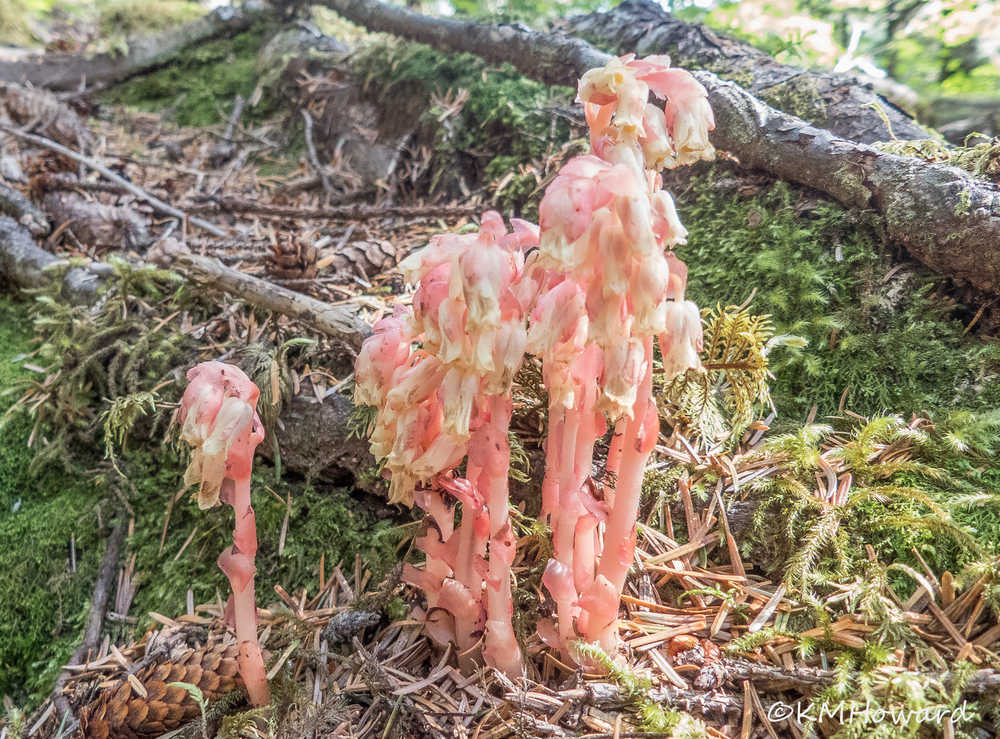The Sheep Creek trail in spring and early summer is almost always good for hearing bird songs, but this day was hot (in Juneau, that means over 70 degrees) and we were there late in the morning, well after the usual dawn chorus.
So I was a bit surprised that the listening was still quite good. I heard several Swainson’s thrushes, which arrive from their wintering area well after the other songbirds. Fox sparrows and robins were singing, presumably starting second broods. A few kinds of warblers were sounding off here and there, and even ruby-crowned kinglets, who start their lively concerts in late March, still sang a little (albeit a trifle feebly).
We found two treats from the plant world. One was a healthy specimen of three-toothed saxifrage (Saxifraga tricuspidata) on a rock near the trail. This species is not common here, being mostly a species of the Interior. It has spotted petals, as does the related spotted saxifrage, which has small, rounded leaves (no teeth).
The other good find was a happy little stand of a parasitic plant called (among other names) pinesap. The taxonomy of this plant has changed, reflecting great confusion about its relationships. It might be called Monotropa hypopitys or Hypopitys monotropa; related to the wintergreens, it is now categorized in the blueberry family (Ericaceae).
In any case, the plant is less confused than the taxonomists: it has no green tissue and is entirely dependent on its hosts for nutrition. Mycorrhizal fungi connect the parasite to conifer trees and transfer nutrients to the parasite. The flowers of pinesap are pendant until pollinated (self-pollinated or perhaps by bees?) but become erect when mature and ready to disperse seeds. These plants are reported to be yellowish if they flower in spring or summer, but reddish if they flower in fall. I have not seen this plant very often around here, but we did see another one this year, over on west Douglas.
A small excitement was stirred by a wasp nest adjacent to the trail, on the ground. We could see the paper wall of the nest through the torn vegetation. Something had already disturbed the colony, which was swarming over the trail as we went into the valley, and the swarm of unhappy wasps was still there two hours later, when we left. No casualties to passing humans, but that nest may not survive.
Gold Ridge never disappoints us: if we tire of looking for marmots or watching eagles catch the thermals to soar up the face of the ridge, there are some nice plants to inspect.
I found a pair of frog orchids along the trail in mid-June, but by late June they were gone — simply finished or maybe trampled. More could be found by a good observer somewhat higher on the ridge.
Butterworts, which catch insects on the sticky leaves, had flowered in the early part of June and by late June some of them were setting seed. The inky or glaucous gentian, with its unusual blue-green flowers was ready to bloom in late June.
Earlier in the season, we had 30 seconds of intense excitement: from over our shoulders came a prolonged, piercing scream and a dark falcon in hot pursuit of a songbird. The songbird dove into a thicket below us. The merlin circled around and back up the ridge, hoping for better luck.
Near the glacier in late June, the dippers had raised one early brood of chicks, but sadly, showed no signs of raising a second brood, even though the pairs that nest at this site often do so, and there was plenty of time this year. Porcupines were busily shredding cottonwood leaves. The sockeye were not yet in and the bears were making themselves quite scarce.
A few years ago, during several spring seasons, bears were commonly seen up in the cottonwood trees, feeding on the catkins and leaving lots of broken branches, but we have not seen much of that activity in recent springs. Quite puzzling!
We had fun keeping track of the robin that chose to nest under the raised walkway. How she tolerated the thousands of tramping feet overhead is a mystery. But she incubated four eggs; one hatched a day after the others, indicating that incubation had begun with the third egg. The female sat on her eggs for around twelve days. When they hatched, the male appeared, and both parents tended the chicks.
In early July, the nestlings survived the rising waters of the jökulhlaup by a few inches and fledged after about two weeks in the nest.
• Mary F. Willson is a retired professor of ecology.

